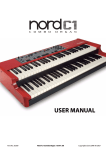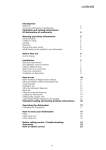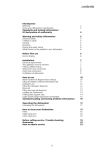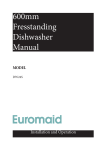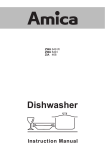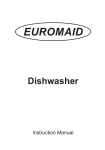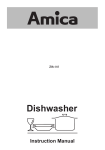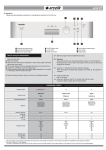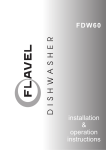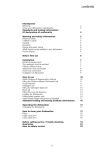Download Blomberg Dishwasher Technical data
Transcript
Dear customer, Before starting, it is essential that you read carefully right through the installation and operation instruction booklet before plugging in to the mains socket. The following instructions should prevent the risk of personal injury and/or damages to the machine. Please keep these documents for later reference in a safe place. This operating manual has been written for different machines and some of the features mentioned here may not apply to your specific machine. 18 9792 01 00-01-B1-GB Table of contents Introduction 1 Disposal Page 3 Recycling.............................................................3 Disposal of your old machine ..............................3 2 Safety Instructions Page 3 Before installation................................................3 Before first use ....................................................3 Childrens safety..................................................4 For daily operation ..............................................4 In the case of problems.......................................4 3 Get to know your machine Page 5 View of the machine............................................5 Control panel.......................................................5 4 How to use your dishwasher Page 6 Softening water ...................................................6 Filling the dishwasher salt ...................................7 Filling the rinse aid dispenser .............................8 Filling the detergent dispenser ............................8 5 What should not be washed in your dishwasher Page 10 6 Loading the dishwasher Page 10 General .............................................................10 Lower basket .....................................................11 Cutlery basket ...................................................11 Upper basket.....................................................12 1 11 Service If your machine ever experiences faults in operation, check the notes and advice in the operating manual. 7 How to clean your dishwasher Seite 14 Cleaning the filters ............................................14 Cleaning the spray arms ...................................15 Cleaning the filter inset .....................................15 If this does not fix the problem, our customer service staff is available to you. 8 Trouble shooting What, if.... Seite 15 The dishwasher will not run ..............................15 The cleaning results are unsatisfactory ............16 9 10 Technical Data Seite 22 Directions for assembly Seite 22 Safety notes for installation ...............................22 Installing your dishwasher.................................23 Water connection ..............................................23 Water drainage..................................................24 Electrical connection .........................................24 11 25 Service Seite 25 2 1 Disposal AQUASAFE+ (depends on the model) 3/4 Recycling The Aquasafe+- system protects you from water damage which may be caused at the water inlet hose. Do not immerse the systems valve box into water; it contains electrical components. In case of damage, pull out the power supply plug. Do not shorten or lengthen the hose insert, since it contains electrical cables and components. min 10 The packaging and some parts of your machine are made from recyclable materials. These materials are marked up with recycling symbol and material type information (PE, PS, POM). Remove the packaging material and dispose of it in accordance with regulations prior to taking the machine into operation. AQUASAFE+ Water drainage Warning Connecting the drainage hose. 21 Disposal of your old machine Before installation Check the machine for transport damages. Never install and use damaged machines. If in doubt, contact your supplier. Before first use See Notes for Installation on page 22. Have the grounding system installed by a qualified electrician. The manufacturer cannot be hold liable for any damages that are due to operating the machine without proper grounding. Before operating the system, please check that the data given on the type plate are in accordance with the data of your power supply. The dishwasher must be separated from the mains during installation. 3 100 90 80 70 60 50 40 30 Siphon connection The drainage height must be between 50 and 100 cm above the floor. Use hose clamps to fasten the drainage hose to the siphon. 20 min 4cm If a hose extension is required, a drainage hose of equal quality must be used The maximum length must not exceed 4m. Otherwise, the machines cleaning process is negatively influenced. 10 min 50 cm 0 12cm max 110 cm 110 Extension hoses Dispose of your old machine in accordance with the disposal guidelines which are in effect at the location where you reside. To avoid dangers, please make the machine unusable until the time of transport. Pull out the mains plug and cut the power cable. Render the door lock unusable. 2 Safety Instructions Take care to ensure that the water intake hose is not bent or squeezed. Check that the drainage hose is firmly seated in place. 18 Packaging materials may be dangerous to children. Reusable substances may be dropped off at the local disposal facilities. You may obtain further information from the authorities and disposal facilities. Electrical connection Please refer to the type plate for information on current type, mains voltage, and fuse protection. The type plate is located on the inside of the door. The mains plug must be freely accessible after installation. Power cables and insulated cables must not be accessible after installation. 24 Installing your dishwasher Choose a suitable location for your dishwasher. Take care to ensure that the machine is standing safely and levelly. Unevenness in the floor can be equalised by adjusting the screw feet. When the machine is standing correctly, the door can be closed without difficulties. Water inlet and drainage hoses must be placed so that they can move freely in order to avoid bending or squeezing them. The machine may not be hooked up in rooms with a temperature below 0° Celsius. Water connection The dishwasher may be connected to cold and warm water to a max. temperature of 60° Celsius. The dishwasher may not be connected to open warm water devices and flow-through water heaters. Permissible water pressure: Lowest permissible water When the water pressure is below 1 bar, please contact your pressure: 0,3 bar = 3 N/cm² = 30 kPa technician. Highest permissible water When the water pressure is above pressure: 10 bar, a pressure reduction valve 10 bar = 100N/cm² = 1MPa must be installed (available in trade supply stores). Connect water inlet hose 3/4 min 10 Take care to ensure that the water inlet hose is not bent or squeezed. Do not install a used hose set. Use a screw-on hose connector to connect the water inlet hose to a water tap with an external thread with a measurement of 3/4 inches. If required, use a filter inset to filter deposits from the pipes. Check that the connection does not leak. 3/4 1/2 CH DK S 3/4 N SF 23 Attention For safety reasons, close the tap after every rinse process. The connection of the machine to the mains may not be made by using an extension cable. Extension cables do not provide the necessary safety (e.g. danger of overheating). Always use the original plug delivered with the machine. The plug must be freely accessible after the machine has been installed. Childrens safety Do not allow children to play with the machine. Dishwasher detergents may have caustic effects in the areas of the eyes, mouth and throat. Please note the safety notes provided by the manufacturers of the detergents. Never leave children unsupervised while the machine is open. Leftovers of the detergents may still be contained in the machine. The water in the dishwasher is not drinking water. Danger of caustic injuries. Always place long and sharp/pointed objects (e.g. serving fork, bread knife) into the cutlery basket with the pointed end down or flat on the upper basket to avoid possible injuries. For daily operation Use your machine only in the household, for the following uses: Washing household dishes. Do not use chemical solvents in the machine; there is a danger of explosion. Do not sit or stand on the opened door or place other things on it. The machine may tip over. Do not open the door while the machine is in operation. Hot water or steam may escape. Do not leave the door open an open door can be a hazard. In the case of problems Repairs and changes to the machine may only be carried out by qualified customer service personnel. In the event of problems or repairs, disconnect the machine from the mains supply: - disconnect the machine by pulling the mains plug - shut off the fuse. Do not pull on the cable pull on the plug. Turn off the water supply tap. 4 3 Get to know your machine View of the machine 9 Technical features 1 2 3 6 4 5 7 8 10 9 12 13 1 Housing 2 Upper basket with rack 3 Guiding track for the upper basket 7 Cutlery basket Prior to installing and using your machine, please check it for possible transport damage. If the machine is damaged, please contact your supplier. Never install and use damaged machines. 8 Lower spray arm 9 Detergent dispenser 10 Filters The following directions must be observed in order to connect the dishwasher properly. 11 Door 12 Control panel 1 13 Turbo fan heat drying system (depending on the model) 5 3 4 5 5 2 3 6 7 4 Programme lights Rinse aid level indicator light Salt level indicator light LED progress indicator lights Programme selection button 9 8 6 7 8 9 Low Voltage Directive EMV directive CE identification directive Electric dishwasher for domestic use Testing method for utilization properties Safety notes for installation 6 Salt container Control panel 73/23/EC 89/336/EC 93/68/EC DIN EN 50242 10 Directions for assembly 4 Upper spray arm 5 Lower basket 2 Because we continually strive to improve our products, we may change our specifications and designs without prior notice. This device corresponds to the following EU Directives: 11 1 Load capacity 12 Permissible water pressure 0,3 10 bar (= 3 100 N/cm² = 0,01-1,0Mpa) Electrical connection 230 Volt, 10 Amps (see type plate) Total power 2000 W Heater power 1800 W Start / Pause button Economy button (depending on the model)7 Door handle On/Off button Make sure that the data on the type plate correspond to the current and voltage of your power supply connections before putting the machine into operation. The connection of the machine may only be made using a properly grounded socket. Ensure that the grounding is in accordance with regulations. The grounded socket must be easily accessible and close to the machine. Do not use extension cables or multiple adapters. There is a possibility of fire hazard through overheating. Hardwiring may only be carried out by a qualified electrician. Check the power cable, the water inlet hose and the drainage hose. Damaged parts may only be exchanged by customer service personnel or by a qualified electrical service expert. 22 4 Setting the water hardness level for the water softener Softening the water Dishwashers require fairly soft water. If the hardness exceeds 6°dH lime scale will form on crockery. To avoid this an automatic system adds a special salt to soften the water so that you obtain the best possible cleaning and drying performance. To find out the hardness level of your water contact your local water company, or use the enclosed test strip to measure the water hardness: Dishes break Possible causes - Load the dishwasher as suggested in the directions. - Overloaded baskets - Do not overload the dish baskets. Dishes may hit against each other and break. Foam How to fix these problems - The dishes were pre-washed by hand with a large amount of dish detergent - Dishes do not need to be pre-washed. Coarse dirt may be removed with a dishcloth, or you may hold the dishes under running water. - Rinse aid has accidentally leaked into the machine - If rinse aid has been spilled during refilling, remove the agent using a paper cloth or sponge. - The cover of the rinse aid dispenser was not closed. - Always take care to ensure that the lid is closed after refilling the rinse aid dispenser. e d Hardness Level 1 6 - Clogged filters - Clean all strainers and filters as described in the manual - Drain hose bent. Relief hose blocked or bent. - Ensure that the relief hose is properly placed. Hold the test strip in the water for about a second. Remove the test strip from the water and shake it. The test strip shows you the hardness level. Wait for 1 minute. Hardness Level 5 How to fix these problems f 1. Press the Program Selection Button before you switch the appliance on and keep this button pressed down. 2. Switch the appliance on using the On/Off Switch, then release the switch. 3. Hold the Program Selection Button down for 10 seconds until the Control Indicator on the Start/Pause Button begins to flash. 4. Water hardness can be set to the desired level by pressing the Program Selection Button (Compare the test strip with the Degrees of Hardness Table). The appropriate LED Status Indicator lights up. 5. Once you have set the hardness level press the Start/Pause Button to save the value. The Control Indicator on the Start/Pause Button now lights up permanently. 4 Water remains inside the machine after the rinse cycle Turn on the tap and let the water run for about a minute Remove the test strip from the packet. 3 21 1 Second 1 Minute 2 Possible causes c b 1 min. How to fix these problems - Improper loading Possible causes a British German hardn. hardn. °dE °dH French hardn. °dF 0-6 0-5 0-9 7-14 6-11 10-20 15-21 12-17 21-30 22-28 18-22 31-40 29-42 23-34 41-60 43-75 35-60 61-107 °dH: German hardness level LED Status Indicators Wash Rinse Dry End Wash Rinse Dry End Wash Rinse Dry End Wash Rinse Dry End Wash Rinse Dry End Wash Rinse Dry End Only the LED Indicator 'Wash' is lit up Only the LED Indicator 'Rinse' is lit up Only the LED Indicator 'Dry' is lit up Only the LED Indicator 'End' is lit up All four LED indicators are lit up All four LED indicators are lit up Regeneration Adjustment Switch 0 1 0 1 0 1 0 1 0 1 0 1 0 1 Regeneration Adjustment Switch 0 1 0 1 0 1 0 1 0 1 0 1 1 °dH = 1 mg CaO/100 ml Water = 0.179 mmol Switch the appliance off again using the On/Off switch. If the water hardness level is less than 5 °dH you do not need any special softening salt. In this case the 'Salt' Control Indicator lights up continually (depending on the model). If your local hardness level exceeds 60°dH you should consider getting a water softening device for your dishwasher. If you use stream water or rainwater you are recommended to install filters. If you move do not forget to adjust the water hardness level to suit your new neighbourhood. Level 6 High lime content If water hardness Level is 6 (high lime content), turn the Regeneration Adjustment switch on position 1. 6 A Filling the dishwasher salt Attention Only use special dishwasher salt in your machine to soften the water. The manufacturer is not liable for damages resulting from the use of the wrong salt type. Do not use coarse grained salt. Small grains or powdered salt is more easily soluble. Never use culinary or table salt. These types of salt do not dissolve in water easily and will damage the function of the softening device. B Paling of decoration Possible causes - Paling of decoration on glasses and porcelain How to fix these problems - Glasses, porcelain and cutlery of this type are not suited for dishwashers. Remove the lower basket from the machine. Open the screw-in cap of the salt container by turning it counter clockwise (Fig. A B ). Scratched dishes Possible causes C When operating for the first time: Pour 1 Litre of water into the salt container (Fig. C ). Pour the salt into the container with the aid of the supplied salt funnel (Fig. D ). Pour in enough salt to fill the container. The container holds approx. 2 kg. Close the cap tightly. D 7 Begin a washing programme immediately after filling the salt container. The washing program prevents damage to the machine which may be caused by any spilled salt solution. After the first washing cycle, the salt level indicator light will go out. - Dish items/parts made from aluminium - The lid of the salt container is not closing properly. - The hardness is not selected properly; too little salt is being used. How to fix these problems - Dishes and cutlery of this type are not suited to dishwashers. - Check whether the lid of the salt container is firmly closed. Use the funnel to pour in special salt. Begin the pre-wash programme right after filling in salt. After the program is complete, check whether the lid may have loosened. - Check the set values with the stated values from the local water board. - Detergents are being stored under unfavourable conditions - Detergents should not be stored longer than 2 months. Store detergents in a dry location. Close the lid of the container carefully. - Overloaded baskets - Take care to ensure that individual glasses and dishes do not touch. They may hit against each other during the washing process, causing scratched. 20 - Food leftovers are staying on the dishes for too long - The machine is not grounded properly - Cutlery parts from low-grade rustfree steel. - Dish items with rust stains Filling the rinse aid dispenser - Remove coarse dirt under running water and carry out the pre-wash program with an interval of 2 days without a detergent. Rinse aids allow washing water to rinse off more cleanly and prevent watermarks or streaks on the dishes. Only use rinse aids suited to use in dishwashers. - Check the grounding of the system. Static electricity may eat holes into metal and cause irreparable damages. - Note If you use 2 in 1 or 3 in 1 detergents / tabs, you do not need an additional rinse aid. B - Rust on such items cannot be avoided. Cutlery or dishes of this type is not suited to dishwashers. Open the rinse aid dispenser by pressing the lock ( B ) - Rusty dishes may infect other items. Cutlery or dishes of this type is not suited to dishwashers. 3 Carefully pour in rinse aid to the MAX mark. Close the lid until it clicks in ( 3 ). Carefully wipe off spilled rinse aid. Excessive rinse aid causes excessive foam formation, which may hinder cleaning. Set the dose of rinse aid The dose of rinse aid to be used can be set by means of the dispenser regulator between levels 1 and 6 ( 4 ). Your machine is pre-set at the factory to level 3. Only change the setting if the following applies after washing: 4 A Turn the lock to the right. Watermarks are visible on the dishes: Set dosage higher Streaks are visible on the dishes: Set dosage lower Filling the detergent dispenser - Note Only use detergents suited to use in dishwashers. Detergent residue remains in the dispenser Possible causes - Moisture in the detergent dispenser - Detergent stays in the dispenser of the dishwasher for too long - The lid of the detergent dispenser does not open. - Detergent is moist or clumping - Spray arm nozzles are clogged. 19 How to fix these problems - Ensure that the detergent dispenser is dry before filling it. - Pour the detergent in just before washing. - When loading the dishwasher, take care to ensure that you do not accidentally open the lid. - Store detergents in a dry location. Close the lid of the container carefully. - Clean the spray arms as described in the manual 1 25cm³ 15cm³ 5cm³ 2 Open the detergent container by pushing the lock to the right ( A ). Marking lines on the inside of the detergent container aid in providing the correct amount of detergent. The detergent container holds a total of 40 cm³ of detergent ( 1 ). When the dishwasher is fully loaded and the dishes are very dirty, we recommend filling the detergent container up to the 25 cm³ mark. When the dishes are less dirty, it is generally sufficient to fill the detergent up to the 15 cm³ mark. If your dishes have been in the dishwasher for some time without being washed, additionally fill the small container up to the top ( 2 ). The detergent amounts for the individual cleaning programmes are shown in the cleaning table. Deviations are possible depending on how dirty the dishes are and on how hard the water is in your location. 8 Detergents There are 3 types of detergents: 1. Phosphate and containing chlorine 2. Phosphate containing, no chlorine 3. Neither containing phosphate nor chlorine The new compact powders are normally phosphate free. As phosphates have water softening properties, we suggest you add salt to the salt container even if the hardness of your water is only 6°dH. In hard water areas, if a phosphate free detergent is used, white marks on the dishes and glasses may be observed. It may be prevented by increasing the amount of detergent. Detergents without chlorine have less bleaching effect. Coloured stains may not be fully removed. Choose a programme with a higher wash temperature. - The hardness is not selected properly; too little salt is being used. - Check the set values with the stated values from the local water board. - Salt loss - Check whether the lid of the salt container is firmly closed. Use the funnel to pour in special salt. Begin the pre-wash programme right after filling in salt. After the program is complete, check whether the lid may have loosened. Attention Always store your detergents in locations which are cool, dry and out of the reach of children. Pour the detergent into the detergent dispenser before turning the machine on. Too much detergent may mean that the detergent does not dissolve properly and dishes are scratched. TWO-IN-ONE AND THREE-IN-ONE DETERGENTS You will obtain the best results from your dishwasher if you use a separate detergent, rinse aid and water-softening salt. Detergent manufacturers also produce combined detergents known as two-in-one and threein-one. Three-in-one: These products contain detergent, rinse aid and water-softening salt. Two-in-one: These products contain detergent and either rinse aid or water-softening salt. Smell Possible causes How to fix these problems - Smell of new machine - The smell of a new machine disappears after a few washing runs. - Filters are dirty - Clean all strainers and filters as described in the manual. - Dishes stand in the machine for a few days without being washed - Remove coarse dirt under running water and carry out the pre-wash program with an interval of 2 days without a detergent. Close the door to avoid the development of smells. In general, you will obtain satisfactory results from combined detergents only under specific usage conditions. These detergents contain predetermined amounts of rinse aid and/or softening salt. This means that you cannot adjust the amount of water-softening salt and rinse aid that you use to suit the water hardness level in your home. You should bear the following points in mind when using such detergents: - Be sure to check the specifications of the product you are using and whether it is a combined product or not. - Follow the instructions on the packet when using these products. - The use of these products at the correct appliance settings will ensure economical use of salt and/or rinse aid. - If the detergent is in tablet form, never place these in the internal section or cutlery basket of the dishwasher. Always place the tablets in the detergent dispenser of the detergent holder. Using three-in-one detergent: detergent, softening salt and rinse aid - These detergents will not give you the same drying performance that you can obtain by using separate detergent, salt and rinse aid. To increase the drying performance: Put your appliances rinse aid setting at 1 and apply rinse aid. When the rinse aid is used up, add more rinse aid to the rinse aid dispenser. - If you use combined detergents with a rinse aid setting higher than 1, contact with the hands may leave rainbow-coloured water stains on the washed items and inside the machine. - If you use combined detergents without adding salt, lime scale may form especially on glasses. To avoid lime scale formation: Put your appliances water softener setting at 1 and add salt. When the salt is used up, add more salt to the water softener. Using two-in-one detergent: detergent and softening salt - These detergents do not contain rinse aid so you need to use the rinse aid setting as described in the manual, making sure that there is rinse aid in the rinse aid dispenser with every wash and that you refill the rinse aid dispenser with rinse aid every time it is empty. Using two-in-one detergent: detergent and rinse aid - These detergents will not give you the same drying performance that you can obtain by using separate detergent, salt and rinse aid. To increase the drying performance: 9 Milky appearance or blue shimmering deposit on the glasses (glass corrosion) Possible causes - Excessive use of detergent when water hardness is low, cleaning temperature is too high How to fix these problems - Choose a programme with a low temperature and add a smaller amount of detergent. Check the set water hardness against the stated values from the local water board. Rust stains, destruction of the surface Possible causes - The lid of the salt container is not closing properly. How to fix these problems - Salt can destroy metal surfaces and cause rust damage. - Check whether the lid of the salt container is firmly closed. Use the funnel to pour in special salt. Begin the pre-wash programme right after filling in salt. After the program is complete, check whether the lid may have loosened. 18 The dishes are not becoming dry Possible causes How to fix these problems - Improper loading - Load the dishwasher as suggested in this booklet. - Insufficient rinse aid supply - Increase the amount of rinse aid / refill the rinse aid dispenser. - Dishes are removed too soon - Do not empty your dishwasher immediately after washing. Open the door slightly so that the steam can escape. Begin with unloading the dishwasher when the dishes are only hand warm. Empty the lower basket first. This prevents water from dripping off dishes in the upper basket. - Wrong programme selection - In short period programmes, the wash temperature and therefore the cleaning performance is lower. Choose a programme with a longer washing time. - Using cutlery with a low surface quality - Water drainage is more difficult with these items. Cutlery or dishes of this type is not suited to dishwashers. Tea, coffee or other stains Possible causes How to fix these problems - Wrong programme selection - Select a programme which washes at a higher temperature or takes longer. - Detergent is moist or clumping - Bleaches in cleaners lose their efficacy when stored under unfavourable conditions. Store detergents in a dry location. Close the lid of the container carefully. - Using cutlery with a low surface quality - Cleaning of these items is made difficult by their surface structure. Cutlery or dishes of this type is not suited to dishwashers. Put your appliances rinse aid setting at 1 and apply rinse aid. When the rinse aid is used up, add more rinse aid to the rinse aid dispenser. - If you use combined detergents with a rinse aid setting higher than 1, contact with the hands may leave rainbow-coloured water stains on the washed items and inside the machine. - These detergents do not contain softening salt so you need to use the softening setting as described in the manual, making sure that there is water-softening salt in the water softener with every wash and that you refill the water softener with salt every time it is empty. Important warning - Should you encounter a problem that has previously never occured after you start using these detergents, contact the detergent manufacturer directly. You will find contact details on the packet. If you stop using this kind of detergent: - Ensure that the salt and rinse aid dispensers are full. - Put the water hardness setting at the highest level and run a wash cycle with the appliance empty. - After washing while empty, return the water hardness setting to the correct level for your mains water hardness shown in the manual. - Put the rinse aid setting at the correct level. 5 What should not be washed in your dishwasher Rust sensitive steel parts: Cutlery with wooden or horn handles Cutlery with mother of pearl or porcelain handles Non heat resistant plastic parts No glued dish or cutlery parts No items made out of copper, tin or aluminium Sensitive decorative glasses and porcelain parts Lead crystal glasses Art and crafted articles Aluminium and silver tend to discolour Glass and crystal articles may lose their shine over time Sponges and dishcloths Note Do not wash items soiled with cigarette ash, candle wax, varnish, paints or chemicals. Recommendation: When buying new dishes, note whether they are suitable for the dishwasher. (marked as dishwasher proof) 6 Loading the dishwasher General: Before you load the dishwasher with dishes Remove coarse food leftovers Place all containers such as cups, glasses and pots into the machine with the opening facing downwards (so that no water can collect) Dishes and cutlery may not be placed above each other Glasses may not touch The movement of the spray arms must not be hindered Place all large and very dirty items in the lower basket. Small and light items can go into the upper basket. Long and narrow items are placed in the middle of the baskets. Attention Calcium streaks, misty appearance 17 Possible causes - Insufficient rinse aid supply How to fix these problems - Increase the amount of rinse aid / refill the rinse aid dispenser Knives and other utensils with sharp tips and edges must be placed horizontally into the upper basket due to risk of injury. Your dishwasher holds a maximum of 12 place settings. Please do not overload your dishwasher and pay attention to the notes regarding dishes which are suited to the dishwasher. Only in this manner will you obtain optimal washing results with a sensible use of energy. 10 Lower basket Suggestions for loading the dishwasher The cleaning results are unsatisfactory Use the lower basket for plates, bowls, pots etc. 4 folding plate support rods (depending on the model) A There are four separate "folding plate support rods" in the lower basket of your dishwasher designed to allow you more space to accommodate saucepans and large bowls in the lower basket. You can either fold each section (1,2,3,4) individually or, all at once, to create a large empty space. Simply press the handgrips ( A ) and fold them down" 1 3 2 4 Variable cutlery basket (depending on the model) The variable cutlery basket can be separated into 3 parts depending on the amount of cutlery and the degree of dirtiness. Small cutlery basket sections also fit into the upper basket. To do this, turn the lock on the handle to the right ( A ). Pull the smaller cutlery basket upwards and out of its holders ( B ) To put the parts together again, proceed in the opposite direction. Use the basket inset ( C ) for your cutlery so that all items in the basket are surrounded by a sufficient water flow. For larger items (e.g. wire whisks), the basket inset may be removed ( C ). The dishes are not becoming clean Possible causes How to fix these problems - Improper loading - Load the dishwasher as suggested in the directions. - Wrong programme selection - Select a programme which washes at a higher temperature or takes longer. - Spray arms are not turning - Check if the spray arms move freely. - Clogged filters - Clean all strainers and filters as described in the manual - Filters are not placed in their proper positions - Check if all strainers and filters are placed in their proper positions - Spray arm nozzles are clogged - Clean the spray arms as described in the manual - Overloaded baskets - Do not overlaod the baskets - Detergent is moist or clumping - Store detergents in a dry location. Close the lid of the container carefully - Too little detergent - Increase the amount of the detergent as per the programme table. - Too little rinse aid - Increase the amount of rinse aid / refill the rinse aid dispenser. - The lid of the detergent dispenser remained open. - Always ensure that you close the detergent dispenser lid after pouring in the detergent. - Using cutlery with a low surface quality - Cutlery of this type is not suited to dishwashers. To make loading easier, the cutlery basket can be removed. Place long items such as ladles, cooking spoons etc. on the rack in the upper basket. A B C 11 16 Cleaning the spray arms A Inset basket with variable height setting (depending on the model) Dirt or calcium residue may block the nozzles on the spray arms. For this reason, regularly check the spray nozzles. 1 You can additionally use this inset in the lower basket for glasses and long-handled cutlery / utensils. 1 Lower spray arm 2 Upper spray arm If you do not need the inset, fold the rack upwards at the angle which is shown ( A ). 1. Remove the lower basket from the machine. 2. Pull off the lower spray arm in an upward direction ( A ). 3. Loosen the fastening screw of the upper spray arm and pull off the spray arm ( B ). 4. Clean the spray arms under running water. 5. Replace the spray arms. 2 B Push the entire inset upwards ( B ). Place the inset in the upright position ( C ). Push the inset down and lock it with the holder ( D ). If you would like to use the basket again, proceed into the opposite direction. For the height setting, push the rack upwards and fold it open in position G. Warning Ensure that the fastening screws are screwed tight. Cleaning the filter inset in the water inlet hose (depending on the model) D A Close the water tap and unscrew the water inlet hose. Take out the filter and clean it under running water. Replace the cleaned filter. Fasten the water inlet hose to the water tap again. When finished, test to ensure that the spray arm can still move freely. D B Dirt from deposits in the water pipes is prevented by a filter in the water inlet hose. Check the filter and the water inlet from time to time. 1. 2. 3. 4. D C G E F Bottle holder (depends on the model) 8 Trouble shooting What if the dishwasher will not run: n Is the machine plugged in? n Are all fuses operative? For cleaning your bottles. To remove, pull both holders apart in opposite directions ( H ). H Upper basket Suggestions for loading the dishwasher Load the upper basket with dessert plates, cups, glasses etc. n Is the water supply fully turned on? n Is the dishwasher door closed firmly? n Have you pressed the On/Off button? n Are the filters clogged? 15 12 Upper basket with variable height setting (depending on the model) A B The upper basket is equipped with a lifting mechanism which enables you to change the height of the basket even if it is fully loaded, and without having to remove it from the dishwasher. The height of the upper basket was set at the factory to the lowest position. To lift the upper basket to the high ( A ) position, hold it on one side and carefully pull it upwards. To lift the opposite side of the basket, hold it and pull it upwards in the same manner ( A ). To lower the upper basket, hold the basket lever on one side and carefully lower the basket without releasing the lever. ( B ). Repeat the procedure with the lever on the opposite side of the basket. Make sure that both levers catch in the same height position. Rack (depends on the model) E Depending on the size of the glasses and cups, the rack height setting may be adjusted ( C D E ). D 7 How to clean your dishwasher C Cleaning your machine at regular intervals ensures longer product life and reduces the risk of reccurring problems. Warning Always unplug the machine and turn off the water supply before cleaning. Use a gentle household cleaner for the outside and the door seals. Clean the control panel only with a moist cloth and clear water. 2 3 Cleaning the filters Clean the filters and the spray arms regularly. A dirty machine will have a negative effect on the cleaning results. A B 1 Main filter 2 Coarse filter 3 Micro filter 1 Height setting with empty basket C In this model, the height setting of the upper basket may be changed using the wheels which are present at two height levels. Release the latches on both the right and left tracks of the upper basket by turning them to the outside ( C ). B Pull out the basket completely ( D ). Place the basket into the tracks again at the desired height ( E ). D Push the latches back into the correct position. 1. Remove the lower basket from the machine. 2. Turn the coarse filter to the right and pull it out in an upward direction ( A ). 3. Pull out the main filter ( B ). 4. Press on the two tongues of the coarse filter and remove the micro filter ( C ). 5. Clean the filters thoroughly under running water. Use a brush if necessary. 6. Replace main filter 7. Replace the micro filter and the coarse filter into the main filter. Twist it clockwise until it clicks in. Warning C Do not operate your dishwasher without a filter. Ensure that your filters are correctly installed Clean the filters regularly. E 13 14














